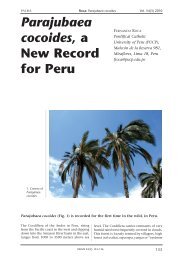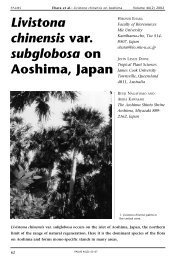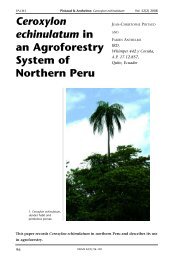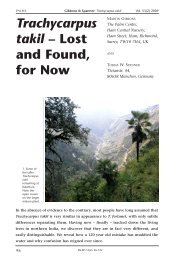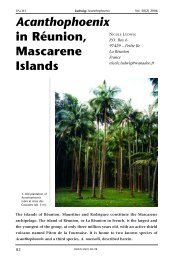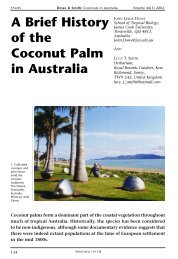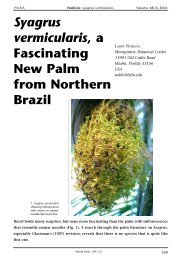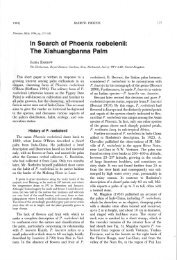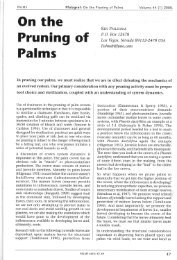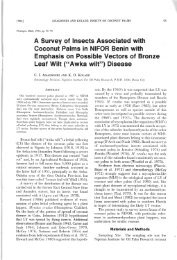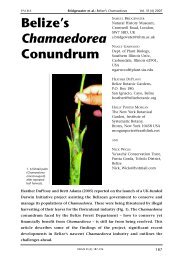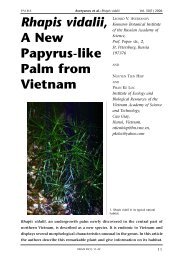Borassus aethioPum, a Threatened Multiple Purpose Palm in Senegal
Borassus aethioPum, a Threatened Multiple Purpose Palm in Senegal
Borassus aethioPum, a Threatened Multiple Purpose Palm in Senegal
You also want an ePaper? Increase the reach of your titles
YUMPU automatically turns print PDFs into web optimized ePapers that Google loves.
B or a, su s aethio pum is an economically<br />
and ecologically important palm tree of the<br />
Sahelian and Sudanian zones <strong>in</strong> Africa (Giffard<br />
1967, Gschladt I972). This majestic<br />
representative of the subfamily Coryphoideae<br />
is often found <strong>in</strong> dense populations<br />
<strong>in</strong> periodically <strong>in</strong>undated depressions <strong>in</strong> the<br />
Iandscape or along rivers and lakes (Chevalier<br />
1949, Chevalier and Dubois i938)'<br />
<strong>Borassus</strong> aethiopurn was orig<strong>in</strong>ally<br />
described by C. F. P. von Martius (1838)<br />
who separated it from the widespread and<br />
closely related Asian species , <strong>Borassus</strong> fla'<br />
bellifer, based on a description of Thonn<strong>in</strong>g<br />
<strong>in</strong> Schumacher (1829). Accord<strong>in</strong>g to<br />
this, B. aethiopum'is characterized by the<br />
ventricose stem (Fig. l) of old <strong>in</strong>dividuals<br />
and the five to seven male flowers <strong>in</strong> each<br />
flower cluster (c<strong>in</strong>c<strong>in</strong>ni) as opposed to ten<br />
to fifteen <strong>in</strong> B. f'abetlifer. The number of<br />
flowers per c<strong>in</strong>c<strong>in</strong>ni is variable and <strong>in</strong> B.<br />
aethiopum it is typically B-10, thus it is<br />
not a good dist<strong>in</strong>guish<strong>in</strong>g character. In<br />
other and older works, B. aethiopum' is<br />
either cited <strong>in</strong> slmonymy with B. f'abellifer<br />
or reta<strong>in</strong>ed as a variety under this. The<br />
only exist<strong>in</strong>g monographic treatment of the<br />
genus <strong>Borassus</strong> is that of Beccari (1924}<br />
This work <strong>in</strong>cludes seven species and recognizes<br />
B. aethiopum with three variants:<br />
vat. senegalensis, var. bagamojensis and<br />
the typical form. B. aethiopurn is dist<strong>in</strong>guished<br />
from B. f'abellifer by hav<strong>in</strong>g a<br />
calyx that is connate to the middle and not<br />
split to the base as <strong>in</strong> this species. In modl48<br />
PRINCIPES<br />
[Vor. 36<br />
Pr<strong>in</strong>cipes, 36(3), 1992, pp. 148-155<br />
<strong>Borassus</strong> <strong>aethioPum</strong>, a <strong>Threatened</strong><br />
<strong>Multiple</strong> <strong>Purpose</strong> <strong>Palm</strong> <strong>in</strong> <strong>Senegal</strong><br />
BrrxvnNu SeMsou,r Jones E. LAwESSoN,'AND ANDER S' Bennoo2<br />
t[Jniuersit6 Cheikh Anta Diop de Dakar, FacuJtE des Sciences,<br />
Institut des Sciences d'e l'Enoironnement, Dakar, <strong>Senegal</strong> and'<br />
zBotanical Institute, Uniuersity of Aarhus, Nordlandsaej 68,<br />
DK-8240 Risskotl- Denmark<br />
ern treatmentsl €.g.: Flore du S6n6gal<br />
(Berhaut 1967), Flora of West Tropical<br />
Africa (Hepper, 1968), Flora of Tropical<br />
East Africa (Dransfield 1986) and, Flore<br />
illustr6e du S6n6gal (Vanden Berghen<br />
I98B) the position of B. aethiopurn is<br />
ma<strong>in</strong>ta<strong>in</strong>ed. We have accePted B.<br />
aethiopurn <strong>in</strong> this paper based on the differences<br />
given by Dransfield (1986). <strong>Borassus</strong><br />
aethiopurn is accord<strong>in</strong>gly more massive<br />
than B. f.abellifer. The leaves are<br />
more rigid, less deeply folded and greater<br />
<strong>in</strong> number. Along with the ventricose stem'<br />
this gives a different appearance from B.<br />
f.abellifer.<br />
<strong>Borassus</strong> aethiopum plays an important<br />
role <strong>in</strong> <strong>Senegal</strong>ese rural life where it<br />
is the source of a number of products (Niang<br />
1975, Diouf 1982, Sambou 1985). It is<br />
called "ron" <strong>in</strong> Wolof dialect from which<br />
the French "r6nier" is derived. Destructive<br />
agricultural practices and lack of management<br />
is now threaten<strong>in</strong>g populations all<br />
over the country (Bellouard 1950, Diallo<br />
1987, Sambou 1989). Dense populations<br />
of Borassas aethiopun't' are {ound <strong>in</strong> the<br />
southern and southeastern parts of <strong>Senegal</strong><br />
close to rivers and lakes where the groundwater<br />
level is high. Natural populations of<br />
Bora,ssus aethioputn are rare <strong>in</strong> the northern<br />
part of <strong>Senegal</strong>, but the palm is often<br />
planted <strong>in</strong> fields (Fig. 2). The best climatic<br />
conditions for this palm prevail <strong>in</strong> the middle<br />
part of the country where large populations<br />
once occurred.
9921<br />
S.{\IBOU ET AL.: BORASSUS IN SENEGAL<br />
t49<br />
l-4' <strong>Borassus</strong> aethiopum- i. Old <strong>in</strong>dividual. Note the swollen or ventricose stem. 2. palm tree planted<br />
<strong>in</strong> mixed cropp<strong>in</strong>g system. Note the male <strong>in</strong>florescence and the persistent leaf sheaths characteristic of yourg<br />
plants' 3' Cross section of immature fruit. Note the fleshy -".o"urp and the three pyrenes that each conta<strong>in</strong><br />
the gelat<strong>in</strong>ous endosperm. 4. Roof thatchei with the leaves.
t50<br />
PRINCIPES [Vor. 36<br />
Overexploitation and habitat degradation<br />
is threaten<strong>in</strong>g this palm so seriously<br />
that <strong>Senegal</strong>ese authorities are now try<strong>in</strong>g<br />
to protect it. It is illegal to exploit the wood<br />
foi commer"ial purposes and other laws<br />
resulate its use <strong>in</strong> the common lands of<br />
thi villages (Government of <strong>Senegal</strong> I973).<br />
Despite these efforts the destruction seems<br />
to 6e cont<strong>in</strong>u<strong>in</strong>g. This paper will first<br />
describe some of the many uses of <strong>Borassus</strong><br />
aethiopum and then mention the various<br />
threats to which it is exposed <strong>in</strong> <strong>Senegal</strong>.<br />
Uses<br />
All parts of <strong>Borassus</strong> dethiopum are<br />
exploited and used for a wide array of<br />
pnipot"t (Table i). The products can b9<br />
airnid"d <strong>in</strong>to three major groups which will<br />
be treated shortly <strong>in</strong> the follow<strong>in</strong>g: ligneous<br />
products (wood, fibers, etc.), food, and<br />
medic<strong>in</strong>e.<br />
A number of parts of the palm are edible.<br />
The young gelat<strong>in</strong>ous endosperm is a<br />
highly esteemed and nutritious snack (Fig.<br />
g). The mesocarp is fleshy when ripe and<br />
can be prepared and consumed <strong>in</strong> many<br />
ways: grilled, boiled, or mixed with sugar<br />
or honey. The.cotyledonary haustorium of<br />
the germ<strong>in</strong>at<strong>in</strong>g seed is soft and sweet and<br />
highly appreciated. The premature folded<br />
leaves of the seedl<strong>in</strong>g are collected from<br />
below the soil and eaten. TheY have a<br />
fleshy texture and are very tasty. The palm<br />
heart of <strong>Borassus</strong> aethiopum is also<br />
exploited although the difficulties <strong>in</strong>volved<br />
<strong>in</strong> extract<strong>in</strong>g it somewhat limit its importance<br />
as a food source. A sap' which is<br />
very high <strong>in</strong> sugar content' is tapped from<br />
near the apical meristem at the base of<br />
the palm heart (Bismuth and Menage<br />
i961).<br />
<strong>Borassus</strong> aethioputrl is also used for a<br />
number of medic<strong>in</strong>al purposes (Giffard<br />
1962). An <strong>in</strong>fusion of the roots is used to<br />
treat miscellaneous ailments such as stomach<br />
ache, throat <strong>in</strong>fections, bronchitis and<br />
syphilis. The flower-bear<strong>in</strong>g branches or<br />
rachillae of the stam<strong>in</strong>ate <strong>in</strong>florescences<br />
are used to treat venereal diseases. The<br />
stamens are mixed with Shea-butter and<br />
Tabte 1. The Dffirent Porls olf<strong>Borassus</strong><br />
aethiopum Used bY Man<br />
I. Uses based on structural properties<br />
[.<br />
O Stem (timber, boards)<br />
O Leaves<br />
-petiole (fences, fibers)<br />
-blade (roofs, baskets, mats, rugs'<br />
furniture)<br />
Uses based on nutritional and medic<strong>in</strong>al<br />
properties<br />
O food<br />
-endosperm<br />
-cotyledonarY haustorium<br />
-palm heart<br />
-mesocarp<br />
-sap tapped from near the shoot apex<br />
(alcoholic beverage)<br />
O medic<strong>in</strong>al<br />
-room<br />
-male rachillae<br />
-stamens<br />
-mesocarp<br />
-hypocotyl<br />
-sap tapped from the trunk or near<br />
the shoot apex<br />
used to heal wounds' The mesocarp of the<br />
ripe fruit is used as a stimulant and aga<strong>in</strong>st<br />
tetanus. It is said to be a very efficient<br />
remedy aga<strong>in</strong>st <strong>in</strong>test<strong>in</strong>al parasites too. The<br />
eophyil (the first leaf) of the seedl<strong>in</strong>g and<br />
the sap are also used as stimulants. The<br />
sap tapped from the stem is believed to<br />
stimulate the growth of teeth <strong>in</strong> children'<br />
The stem of <strong>Borassus</strong> aethiopurndelivers<br />
a hard wood that is resistant to decay<br />
and the damag<strong>in</strong>g effects of seawater. The<br />
durable wood is rarely attacked by termites<br />
and funei and is said to have excellent<br />
work<strong>in</strong>g-properties. It is used extensively<br />
by local carpenters for multiple purposes'<br />
to mention just a few: furniture, timber <strong>in</strong><br />
heavy construction such as bridges and<br />
houses, boards for mak<strong>in</strong>g floors, walls and<br />
roofs <strong>in</strong> houses. The soft swollen part of<br />
old trunks serves other purposes (Fig. 5)'<br />
A rich cottage <strong>in</strong>dustry is based on the<br />
extraction of the leaves. The blade or seg-
9921<br />
SA}IBOU ET AL.: BORASSUS IN SENEGAL<br />
r51<br />
. - ". I<br />
I l<br />
1,,t::<br />
5-8. <strong>Borassus</strong> aethiopum. 5. A beehive made of the swollen and soft part of the trunk. 6. Baskets<br />
braided from the major ve<strong>in</strong>s of the leaves- ;. The fruit mesocarP ofers a nutritious snack' The chairs and<br />
table are made from leaf petioles. 8. The death of some old palm trees such as these is probably related to<br />
droueht.<br />
ments of the blade are used with great<br />
<strong>in</strong>genuity for mak<strong>in</strong>g thatch, mats, rugs,<br />
baskets (Fig. 4), bathtubs, etc. The leaf<br />
fibers are extracted and used for brooms<br />
and baskets (Fig. 6). The leaf petioles are<br />
skillfully exploited <strong>in</strong> arts and crafts (Fig.<br />
7) and are used to build fences around<br />
houses and pastures. In the North, where<br />
the vegetation is sparse, leaf petioles often<br />
serve as firewood.<br />
Several aspects ofthe ecology of <strong>Borassus</strong><br />
aethiopum make it an <strong>in</strong>terest<strong>in</strong>g plant<br />
from an agricultural po<strong>in</strong>t of view. Its<br />
fibrous root system forms a dense mat <strong>in</strong><br />
the surface Iayers of the soil which helps<br />
to prevent soil erosion. It has been demonstrated<br />
that the stam<strong>in</strong>ate rachillae<br />
release potassium upon decomposition<br />
thereby enhanc<strong>in</strong>g soil fertility (Maydell<br />
1983). These beneficial effects are<br />
exploited <strong>in</strong> many parts of <strong>Senegal</strong> where<br />
agro-forestry systems are based on managed<br />
natural populations of Borasszrs<br />
aethiopum.
52<br />
PRINCIPES<br />
[Vor 36<br />
9 12. Borasus aethiopum. 9. Male (left) and female of Oryctes monoceros Ol. (family Scarabei-<br />
I0' The<br />
4"").<br />
signs of an Oryctes attack <strong>in</strong> a juvenile palm. II. Tapp<strong>in</strong>g of sugar from the crown.<br />
Exploitation has caused the death of the palm tree at the left. 12. Borassui aethiopurn must give way for<br />
the cultivation of millet.<br />
Threats<br />
The destruction of Boras sus aethio pum<br />
is either a result of complete removal of<br />
natural populations or a slower process<br />
where age distribution becomes progressively<br />
more skewed. This process may<br />
eventually lead to a complete lack of young<br />
stages <strong>in</strong> the population which can prevent<br />
future regeneration. The factors respon-
9921<br />
SAMBOU ET AL.: BORASSUS IN SENEGAL<br />
HUMAN FACTORS<br />
I<br />
V<br />
I53<br />
Fire<br />
Exploitation ol leaves<br />
Exploitation oi wood<br />
Exploitation of sap<br />
lrom stem<br />
"tii:x'l::<br />
v / [l 8:il[: monoceros<br />
"ti';:'Hi""*<br />
ffi-/ Z:l:::: il::"""'"" Il 3i::T;, n'n""<br />
Exploitation M oryctes gigas Fungi<br />
ol sap from stem I<br />
Asriculrure<br />
| +<br />
|<br />
t<br />
* NATURAL FAcroRS ><br />
\ {<br />
Wk ili:i:: 3*:.""'"'<br />
/<br />
I<br />
@<br />
Fire<br />
Exploitation<br />
oi green fruit<br />
Fire<br />
Agricultu re<br />
Exploitation<br />
ol nut<br />
Exploitation of eophyll<br />
t I<br />
t3. Natural and hman factors caus<strong>in</strong>g degradation of Borasszs aethiopum populations <strong>in</strong> <strong>Senegal</strong>.<br />
sible for destruction of <strong>Borassus</strong> aethiopum<br />
can be divided <strong>in</strong>to two major groups: natural<br />
and anthropogenic (Fig. l3).<br />
The most important natural factor<br />
threaten<strong>in</strong>g populations of <strong>Borassus</strong><br />
aethiopum is probably drought. A steadily<br />
grow<strong>in</strong>g ra<strong>in</strong> deficit dur<strong>in</strong>g the last two<br />
decades has caused high mortality among<br />
older palm trees that are sensitive to fluctuations<br />
<strong>in</strong> the ground water level (Fig. 8).<br />
Destructive <strong>in</strong>sects also represent a serious<br />
threat to <strong>Borassus</strong> aethiopum (Castel-<br />
Branco and Tordo 1956, Lepesme 1947).<br />
After the apical meristem has appeared
t54<br />
PRINCIPES<br />
[Vor. 36<br />
from below the soil, it is exposed to the<br />
attack of three species of Oryctes Ildtger<br />
(Scarabeidae) <strong>in</strong> particular. The two most<br />
common species are Oryctes rrlonoceros<br />
Olivier (Fig. 9) and. Oryctes boas Fabricius.<br />
The third species, Oryctes gigas Castelneau,<br />
is rare but is found <strong>in</strong> the humid<br />
southern part of <strong>Senegal</strong>. All three beetles<br />
dig <strong>in</strong>to the base of the apical meristem<br />
(Fig. I0) and suck the sap which often<br />
results <strong>in</strong> the death of the palm tree. They<br />
can reproduce <strong>in</strong> the swollen subdistal part<br />
of the stem of old <strong>in</strong>dividuals. The partly<br />
decomposed dead stems offer ideal conditions<br />
for the development of larvae.<br />
Man's activities have had a severe<br />
impact on natural populations of Bora,ssus<br />
aethiopum <strong>in</strong> <strong>Senegal</strong>. The ma<strong>in</strong> factors<br />
contribut<strong>in</strong>g to the destruction are agriculture<br />
(Fig. I2), fire and, exploitation of<br />
wood, and use of palmheart and sugar sap<br />
tapped from near the apical meristem. The<br />
latter is a very destructive practice where<br />
a hole is drilled through the leaf bases (Fig.<br />
I l) and a sap is tapped from the soft and<br />
fleshy tissues near the apical meristem.<br />
Usually the palm dies after hav<strong>in</strong>g been<br />
exploited <strong>in</strong> this way. It should be noted<br />
that <strong>in</strong> India and SE Asia, <strong>in</strong>florescences<br />
of <strong>Borassus</strong> flabellifer are tapped without<br />
damag<strong>in</strong>g the plant.<br />
In some <strong>Borassus</strong> aethiopum populations,<br />
the age-distribution is so skewed that<br />
certa<strong>in</strong> developmental stages are completely<br />
lack<strong>in</strong>g. What appears to be seedl<strong>in</strong>gs<br />
are <strong>in</strong> fact very old <strong>in</strong>dividuals, that<br />
rema<strong>in</strong> small due to agricultural practices<br />
such as burn<strong>in</strong>g of the ground cover.<br />
Adult <strong>in</strong>dividuals of <strong>Borassus</strong> aethiopurn<br />
deliver a number of products that are highly<br />
appreciated by village people and they are<br />
consequently threatened by overexploitation.<br />
Thus. reoeated collection of leaves<br />
may severely limit the growth of the palm<br />
and excessive extraction of green fruits,<br />
germ<strong>in</strong>ated seeds or young seedl<strong>in</strong>gs may<br />
impede the potential of natural regeneration.<br />
Conclusion<br />
<strong>Borassus</strong> aethiopum, a genu<strong>in</strong>e multiple<br />
purpose palm tree, is a victim of its<br />
own high utilitarian value. Both human and<br />
natural factors are threaten<strong>in</strong>g the natural<br />
populations <strong>in</strong> <strong>Senegal</strong>. As long as the use<br />
of this valuable palm is not regulated, the<br />
situation will probably worsen. Only strict<br />
management of the rema<strong>in</strong><strong>in</strong>g natural populations<br />
will save an important plant<br />
resource for future generations.<br />
Acknowledgments<br />
Soecial thanks are due to the <strong>in</strong>habitants<br />
of the villages of Tchankoumalal, Baghangha,<br />
Tendouck and Pire Goureye for their<br />
k<strong>in</strong>d assistance <strong>in</strong> the field and for provid<strong>in</strong>g<br />
much valuable <strong>in</strong>formation. We are<br />
thankful to A. Goudiabv. Dakar who took<br />
the photographs. R. Roy, Dakar who<br />
determ<strong>in</strong>ed the collected <strong>in</strong>sects and K.<br />
T<strong>in</strong>d and A. Sloth who assisted skillfully<br />
with the preparation of illustrations.<br />
LrrnReruRn Crten<br />
Beccaru, O. 1924. <strong>Palm</strong>e della Tribir Borasseae<br />
(ed. Martelli). G. Passeri, Firenze, Vol. I, pp. 1-<br />
tt.<br />
Btrroue.nl, P. 1950. Le r6nier en A.O.F. Bois et<br />
For6ts des Tropiques I 4.<br />
BERHAUT, J. L967. Flore du S6n6gal. Clairafrique,<br />
Dakar.<br />
BISMUTH, H. eno G. MENAcE. 1961. Les boissons<br />
alcooliques en A.O.F. Bull. IFAN 23 (s6r. B,<br />
I-2):60-II8.<br />
Cesffi-Bnenco, A. J. F. eNo G. C. ToRDo. 1956.<br />
Acerca do equilibrio bioecologico dos povoamentos<br />
de "cibes" Borasszs sDD. na Gu<strong>in</strong>6 Portuguesa.<br />
M<strong>in</strong>ist6rio do ultramai Junta de Investigacoes<br />
do Ultramar, pp. 53-59.<br />
CHrv,trrnR, A. 1949. R6partition g6ographique et<br />
exploitation des palmiers <strong>Borassus</strong>. Revue <strong>in</strong>ternationale<br />
de botanique appliqu6e et d'agriculture<br />
tropicale 325 326; 585-592.<br />
Cnrvetton,A. ANDR. DuBoIs. I938. Lespalmiers<br />
Hyphaene et Borasszs de l'Afrique occidentale.<br />
Revue <strong>in</strong>ternationale de botanique appliqu6e et<br />
d'agriculture tropicale I98: 93-I03.<br />
DIALLo, M. 1987. Le comportement du r6nier<br />
(<strong>Borassus</strong> aethiopum Mart.) dans les r6neraies
9921<br />
SAMBOU ET AL.: BORASSUS IN SENEGAL 155<br />
paysannes des r6gions de Fatick et de Thi6s<br />
(S6n6gal). Univ. Laval, M6m. de maitrise.<br />
DIour,S. I982. Ler6nierauS6n6gal. Dijon, ENS-<br />
SAA, M6m. d'6tude.<br />
DRexsrrnto, J. 1986. <strong>Palm</strong>ae. In: R. M. Polhill<br />
(ed.). Flora of Tropical East Africa. Balkema,<br />
Rotterdam, pp. l8-2I.<br />
Grrreno, P.L. 1962. Utilisation de quelques produits<br />
forestiers dans la sorcellerie et la pharmacop6e<br />
du S6n6gal oriental. Bois et For6ts des<br />
Tropiques 84:3-12.<br />
1967. Le palmier r6nier. Extr. du<br />
Bull.d'<strong>in</strong>formation du C.T.F.T. 5.<br />
Govrnnurnr oF SENEGAL. 1973. D6cret no. 73"<br />
327 du 3I mars 1973 portant modification des<br />
taxes d'exploitation forestidre et <strong>in</strong>stituant de<br />
nouvelles taxes. J.O. no. 4292. Juornal Officiel<br />
de la R6publique du S6n6gal, I18d ann6e, pp.<br />
1022-1024.<br />
GScHLADT, W. 1972. Le r6nier au Dallol Maouri,<br />
Niger. Bois et For6ts des Tropiques I45.<br />
HrppnR, F. N. 1968. Flora of West Tropical Africa.<br />
The Whitefriars Press, Ltd., London and Tonbridge,<br />
Vol. 3(l), pp. I68-169.<br />
LEPESME, P. 1947. Les <strong>in</strong>sectes des palmiers. P.<br />
Lechevalier. Paris.<br />
MenrIus, C. F. P. voN. 1848. Historia naturalis<br />
palmarum. Mi<strong>in</strong>chen, Vol. 3, pp. 219-222.<br />
MeYonrt, H..J. von. I983. Arbres et arbustes du<br />
Sahel. Leurs caract6ristiques et leurs utilisations.<br />
Eschborn, GTZ.<br />
Nmnc, M. 1975. Le r6nier dans la r6gion de Thids.<br />
Notes africa<strong>in</strong>es, IFAN 147: 77-82.<br />
SAMBou, B. 1985. La r6neraie class6e de Baghangha,<br />
une formation sp6cifique i usages multi<br />
ples-6tude de la r6g6n6ration naturelle, <strong>in</strong>ventaire<br />
et 6laboration d'un tarif de cubaee du r6nier.<br />
Univ. Dakar. I.S.E.. M6m. de D.E.A.<br />
1989. R6nier (<strong>Borassus</strong> aethiopumMart.)<br />
et r6neraies au S6n6gal: 6tat actuel et conditions<br />
de restauration. Univ. C.A,D.. Dakar. Thdse 3e<br />
Cycle.<br />
Scxultecnrn, F. C. 1829. Bekrivelse afGu<strong>in</strong>eiske<br />
Planter, Andet Stykke. Kongel. Danske Vidensk.<br />
Selsk. Naturvidensk. Math. Afh., 4 rekke 4:<br />
217,219.<br />
VeNlrn BnRcHrN, C. l9BB. Flore illustr6e du<br />
S6n6gal. Clairafrique, Dakar, Vol. 9, pp.77-<br />
79.<br />
Pr<strong>in</strong>cipes,36(3), 1992, pp. 155 162<br />
Biogeography of the Coconut<br />
Cocos nucifera L.<br />
HucH C. HeRnros<br />
National Coconut Deuelopment Programne, P-O. Box 6226, Dar es Salaam, Tanzania<br />
ABSTRACT<br />
The conditions under which cocontt (Cocos nucif<br />
era L.) evolved can be quite precisely specified. Thoie<br />
conditions still exist today and the coconut palm can<br />
be found grow<strong>in</strong>g <strong>in</strong> its orig<strong>in</strong>al habitat where it will<br />
cont<strong>in</strong>ue to thrive, with or without human <strong>in</strong>tervention.<br />
The coconut can be considered as perhaps the<br />
most successful member of the world's oldest and<br />
most durable ecosystem. Yet the major component<br />
of that ecosystem, the coral reef, is constantly chang<strong>in</strong>g<br />
its form. As a result the precise location of a<br />
center of orig<strong>in</strong> for the coconut will probably never<br />
De Known.<br />
The coconut, like the calabash and the<br />
bottle-gourd. is used as a convenient conta<strong>in</strong>er<br />
wherever modern man has not yet<br />
brought the ubiquitous benefits of plastic.<br />
Unlike the calabash or the gourd, the coconut<br />
comes already filled with a dr<strong>in</strong>kable<br />
liquid. This liquid is pure, it is palatable<br />
and it is portable. Unlike a plastic conta<strong>in</strong>er<br />
the coconut fruit is non-returnable,<br />
absolutely disposable and totally recyclable.<br />
These qualities are found <strong>in</strong> the immature<br />
coconut and they are well known



